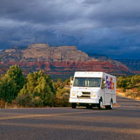
In 2000, as passenger hybrid cars were just beginning to grow in popularity, FedEx teamed with Environmental Defense Fund (EDF) on an ambitious project to make the standard delivery truck more environmentally friendly.
At the time, a handful of companies had tested cleaner vehicle technology, such as hybrids, but few had made commitments to add them to their commercial fleets. FedEx had long sought efficiencies in fleet operations to reduce fuel use and pollution, but we recognized that advanced technology had the potential to greatly enhance those benefits.
Our work with EDF was a collaborative effort. The process began by clearly defining our goals for the vehicle: (1) improve environmental performance, (2) maintain or improve operational performance and (3) increase market share for clean delivery vehicles. To achieve this final goal, we decided the technology would not be proprietary and we would work with EDF to advocate for more adoption.
A request for proposal was issued to the industry, and FedEx and EDF selected Eaton Corporation and Freightliner Custom Chassis Corporation to build the FedEx hybrid-electric truck. One year later, the first available commercial hybrid delivery truck was placed into service on FedEx routes. The hybrid trucks improve fuel economy by 42 percent, reduce greenhouse gas emissions by 25 percent and cut particulate pollution by 96 percent.
Today, the success story for cleaner truck technology continues. Worldwide, FedEx Express is operating 408 vehicles with drive train configurations other than our standard diesel/gasoline-burning power sources. Forty-three of them are all-electric and 365 are hybrid diesel-electric or gasoline-electric. Those 408 have driven over 9.5 million miles to reducing fuel use by almost 276,000 gallons and carbon dioxide emissions by approximately 2,800 metric tons. The FedEx hybrid vehicle project has been recognized by the Environmental Protection Agency (EPA), Harvard University and WestSTART-CALSTART for its role in spurring hybrid truck advancements.
The effort has also helped spur expansion of the technology in the market. While FedEx once sourced hybrids from only one supplier, today we use technologies from seven different companies — Eaton Corporation, Isuzu, Azure Dynamics and Iveco. In 2005 we had the only 18 hybrid commercial vehicles on the road. Now we have 330 and there are over 1,700 hybrid delivery trucks on the road in the U.S., used by a wide variety of companies.
FedEx has continued its role as a leader in the industry by encouraging more companies to purchase and develop clean-technology trucks. Our vehicle experts have participated in numerous industry conferences and gatherings to educate companies about the benefits of cleaner truck technology. We have also championed the need for a smaller engine for application in hybrid vehicles following the 2007 EPA federal engine standard to replace the existing larger, less efficient engine.
We recognize that government support will give a major boost to this technology. FedEx is the only transportation company to publicly call for fuel efficiency standards for commercial medium and heavy-duty truck classes. In addition, FedEx has been an advocate for government incentives at the national, state and local levels to offset the higher capital costs of cleaner vehicles while the market is developing, and our CEO and Chairman Frederick W. Smith has testified numerous times before Congress regarding the electrification of transportation.
There remains tremendous potential for growth in the cleaner vehicle technology market. Mitch Jackson, vice president of environmental affairs and sustainability at FedEx explains, “It’s time for the truck manufacturing industry to create its version of the Prius: clean, affordable and widely available for truck fleets.”
The integration of cleaner vehicles into our fleet has extended beyond hybrids and across a number of markets:
- Among these vehicles are 43 all-electric commercial vehicles deployed in Chicago, London, Los Angeles, Memphis, New York City and Paris.
- FedEx has 365 hybrid-electric delivery vehicles, including an all-hybrid station in New York City.
- FedEx operates 58 trucks fueled by CNG (compressed natural gas), LNG (liquefied natural gas), and LPG (liquefied petroleum gas), in Europe, the Asia Pacific and Latin America.
- FedEx has more than 320 LPG and electric-powered ground support equipment in use at the CDG hub in Paris and other operational facilities across Europe, with another 55 on order.
- FedEx is a founding member of CAREX in France, an association committed to using rail as an alternative logistics solution to deliver European express cargo, thus reducing noise and carbon emissions.
- In Japan, we teamed with General Motors in the test operations of a fuel-cell delivery vehicle for one year.
- FedEx Ground is working with Parker Hannifin Corporation to test a hybrid hydraulic technology with on a heavier class vehicle (Class 6).
- We operate biodiesel trucks on routes in the Washington, D.C., area as well as hybrid electric trucks.
- FedEx Office uses 7 hybrid passenger vehicles to support its sales and delivery operations.
- FedEx operates a large number of electric and alternative-fuel support vehicles worldwide, including more than 500 forklifts and 1,600 ground equipment units at airports.
- Couriers in New York City and in London’s West End deliver many of their packages on foot, reducing vehicle emissions and traffic congestion, and in Paris we have an electric tricycle delivery vehicle.